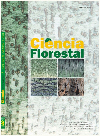
|
Ciência Florestal
Centro de Pesquisas Florestais - CEPEF, Departamento de Ciências Florestais - DCFL, Programa de Pós Graduação em Engenharia Florestal - PPGEF
ISSN: 0103-9954
EISSN: 0103-9954
Vol. 24, No. 4, 2014, pp. 1027-1036
|
 Bioline Code: cf14097
Bioline Code: cf14097
Full paper language: English
Document type: Research Article
Document available free of charge
|
|
|
Ciência Florestal, Vol. 24, No. 4, 2014, pp. 1027-1036
| en |
THE EFFECT OF FIRE OVER RICHNESS OF ANTS (HYMENOPTERA: FORMICIDAE) ASSOCIATED TO Pinus elliottii  ENGELM. IN SOUTHERN BRAZIL ENGELM. IN SOUTHERN BRAZIL
Boscardin, Jardel; Costa, Ervandil Corrêa; Delabie, Jacques Hubert Charles & Garlet, Juliana
Abstract
This work aimed at assessing the effect of fire over an ant fauna associated to Pinus elliottii

Engelm. The
study was developed in the city of Santa Maria, Rio Grande do Sul, in an experimental area next to the
Campus of Universidade Federal de Santa Maria (UFSM), in a 28-year-old plantation of an hectare of
Pinus elliottii, spacing 2m x 2m, on which a fire happened in the end of November, 2008. One month later,
an ant fauna sampling was initiated, being concluded in November, 2009. The method of interception
of wandering insects has been used through soil traps without attraction, distributed in the center of the
population, being prepared 10 traps in simple linear transection, in intervals of 10 meters that remained
buried for 48 hours. After such period, the biological material was packed in plastic pots, transported to the
laboratory for a triage, where the ants were separated into morphospecies and proceeded to identification. From the surveys, 25 ant species were found, distributed in eleven genera, eight tribes and four subfamilies.
From these, the ones who presented the biggest occurrence frequencies in their respective subfamilies were
Pseudomyrmex termitarius

(46,7%), Acromyrmex crassispinus

and Pachycondyla striata

(both with 35,8%),
and Camponotus blandus

(25,0%). Fire is an agent of environmental disturbance many times significant,
causing positive and negative effects over the edaphic fauna. Its action might have caused a negative indirect
effect over Crematogaster victima

and positive over Pseudomyrmex termitarius, Acromyrmex crassispinus,
Pachycondyla striata and Camponotus blandus present in the understory of Pinus elliottii, after the fire.
forest entomology; forest fire; bioindicator insects
|
| |
| pt |
EFEITO DO FOGO SOBRE A RIQUEZA DE FORMIGAS (HYMENOPTERA: FORMICIDAE) ASSOCIADAS À Pinus elliottii  ENGELM. NO SUL DO BRASIL ENGELM. NO SUL DO BRASIL
Boscardin, Jardel; Costa, Ervandil Corrêa; Delabie, Jacques Hubert Charles & Garlet, Juliana
Resumo
Este trabalho objetivou avaliar o efeito do fogo sobre a fauna de formigas associada à Pinus elliottii

Engelm.
O estudo foi desenvolvido no município de Santa Maria, Rio Grande do Sul, numa área experimental
junto ao Campus da Universidade Federal de Santa Maria (UFSM), em um plantio de um hectare de
Pinus elliottii com 28 anos de idade e espaçamento de 2 m x 2 m, no qual ocorreu um incêndio ao final
de novembro de 2008. Um mês após, iniciou-se uma amostragem da fauna de formigas, concluída em
novembro de 2009. Utilizou-se o método de interceptação de insetos perambulantes através do uso de
armadilhas de solo sem atrativo, distribuídas no centro do povoamento, sendo dispostas 10 armadilhas em
transecto linear simples, em intervalos de 10 metros permanecendo enterradas por 48 horas. Ao final deste
período, o material biológico foi acondicionado em potes plásticos e encaminhado ao laboratório para
triagem, onde as formigas foram separadas em morfoespécies e prosseguiram para identificação. A partir
dos levantamentos foram encontradas 25 espécies de formigas distribuídas em onze gêneros, oito tribos
e quatro subfamílias. Destas, as que apresentaram maiores frequências de ocorrência em suas respectivas
subfamílias foram Pseudomyrmex termitarius

(46,7%), Acromyrmex crassispinus

e Pachycondyla striata

(ambas com 35,8%), e Camponotus blandus

(25,0%). O fogo é um agente de distúrbio ambiental por vezes
significativo, causando efeitos positivos e negativos sobre a fauna edáfica. Sua ação pode ter gerado efeito
indireto negativo sobre Crematogaster victima

e positivo sobre Pseudomyrmex termitarius, Acromyrmex
crassispinus, Pachycondyla striata e Camponotus blandus presentes no sub-bosque de Pinus elliottii,
pós-incêndio.
entomologia florestal; incêndio florestal; insetos bioindicadores
|
| |
© Copyright 2014 - Ciência Florestal
Alternative site location: http://cascavel.ufsm.br/revistas/ojs-2.2.2/index.php/cienciaflorestal/index
|
|
